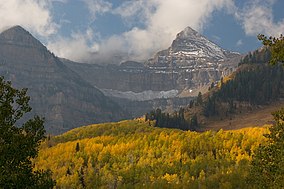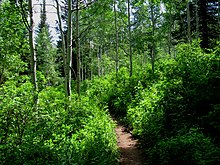Uinta National Forest /juːˈɪntə/ is a national forest located in north central Utah, US. It was originally part of the Uinta Forest Reserve, created by President Grover Cleveland on 2 February 1897. The name is derived from the Ute word Yoov-we-teuh which means pine forest. Because of changes to the boundaries over the years, the Uinta Mountains are now located in the Wasatch-Cache National Forest. In August 2007 it was announced that the Uinta National Forest would merge with the Wasatch–Cache National Forest based in Salt Lake City, Utah, 50 miles (80 km) north of Provo, Utah.[3]
| Uinta National Forest | |
|---|---|
 Uinta National Forest | |
| Location | Juab, Sanpete, Utah, and Wasatch counties, Utah, U.S. |
| Nearest city | Provo, UT |
| Coordinates | 40°15′N 111°17′W / 40.250°N 111.283°W |
| Area | 880,719 acres (3,564.14 km2)[1] |
| Established | 2 February 1897 |
| Visitors | 3,200,000[2] (in 2006) |
| Governing body | U.S. Forest Service |
| Website | Uinta-Wasatch-Cache National Forest |

The Uinta National Forest was headquartered in Provo, Utah, with four outlying district offices located in Pleasant Grove, Heber, Spanish Fork, and Nephi, Utah until August 2007. The Uinta National Forest is now managed as one unit along with the Wasatch–Cache National Forest as the Uinta–Wasatch–Cache National Forest. Managing 880,719 acres (1,376.1 sq mi; 356,414.3 ha), the Uinta National Forest is less than 45 minutes south of Salt Lake City and only minutes away from Provo, Utah. In descending order of land area it is located in parts of Utah, Wasatch, Juab, and Sanpete counties.[4]
One of the most prominent features of the Uinta National Forest is the Mount Timpanogos mountain peak, towering over 11,750 feet (3,580 m) above sea level. However, the highest point in the Unita National Forest (as well as the entire Wasatch Range) is the nearby Mount Nebo at 11,928 feet (3,636 m) above sea level.[5]
Wilderness areas
editThere are three officially designated wilderness areas in Uinta National Forest that are part of the National Wilderness Preservation System. One of them lies partly in neighboring Wasatch National Forest.
- Lone Peak Wilderness (partly in Wasatch NF)
- Mount Nebo Wilderness
- Mount Timpanogos Wilderness
Climate
editThere is a SNOTEL weather station near Trial Lake, in the west of the Uinta Forest at 10000 feet. It features a subalpine climate (Köppen Dfc) with continental characteristics. This climate type is one of the most prevalent in the forest, particularly at higher elevations.
| Climate data for Trial Lake, Utah | |||||||||||||
|---|---|---|---|---|---|---|---|---|---|---|---|---|---|
| Month | Jan | Feb | Mar | Apr | May | Jun | Jul | Aug | Sep | Oct | Nov | Dec | Year |
| Record high °F (°C) | 53 (12) |
58 (14) |
84 (29) |
86 (30) |
77 (25) |
82 (28) |
89 (32) |
83 (28) |
80 (27) |
72 (22) |
60 (16) |
53 (12) |
89 (32) |
| Mean maximum °F (°C) | 42 (6) |
43 (6) |
50 (10) |
56 (13) |
61 (16) |
71 (22) |
76 (24) |
73 (23) |
68 (20) |
58 (14) |
48 (9) |
41 (5) |
76 (24) |
| Mean daily maximum °F (°C) | 27.7 (−2.4) |
29.5 (−1.4) |
38.0 (3.3) |
42.8 (6.0) |
49.8 (9.9) |
59.3 (15.2) |
67.1 (19.5) |
65.0 (18.3) |
56.2 (13.4) |
43.8 (6.6) |
33.0 (0.6) |
26.2 (−3.2) |
44.9 (7.2) |
| Daily mean °F (°C) | 18.4 (−7.6) |
18.3 (−7.6) |
24.6 (−4.1) |
29.4 (−1.4) |
38.3 (3.5) |
48.1 (8.9) |
55.5 (13.1) |
54.1 (12.3) |
46.0 (7.8) |
33.8 (1.0) |
23.2 (−4.9) |
16.8 (−8.4) |
33.9 (1.1) |
| Mean daily minimum °F (°C) | 8.2 (−13.2) |
6.6 (−14.1) |
11.6 (−11.3) |
16.8 (−8.4) |
24.9 (−3.9) |
34.6 (1.4) |
42.1 (5.6) |
40.9 (4.9) |
32.9 (0.5) |
22.8 (−5.1) |
12.8 (−10.7) |
6.9 (−13.9) |
21.8 (−5.7) |
| Mean minimum °F (°C) | −9 (−23) |
−10 (−23) |
−3 (−19) |
4 (−16) |
12 (−11) |
23 (−5) |
35 (2) |
33 (1) |
20 (−7) |
7 (−14) |
−4 (−20) |
−10 (−23) |
−16.2 (−26.8) |
| Record low °F (°C) | −28 (−33) |
−31 (−35) |
−17 (−27) |
−14 (−26) |
−8 (−22) |
3 (−16) |
15 (−9) |
13 (−11) |
4 (−16) |
−22 (−30) |
−28 (−33) |
−30 (−34) |
−31 (−35) |
| Average precipitation inches (mm) | 4.49 (114) |
4.24 (108) |
4.11 (104) |
3.86 (98) |
3.39 (86) |
2.07 (53) |
1.78 (45) |
2.21 (56) |
2.54 (65) |
3.04 (77) |
3.69 (94) |
4.17 (106) |
39.59 (1,006) |
| Average extreme snow depth inches (cm) | 62 (160) |
72 (180) |
76 (190) |
71 (180) |
54 (140) |
16 (41) |
1 (2.5) |
0 (0) |
1 (2.5) |
19 (48) |
26 (66) |
49 (120) |
80 (200) |
| Source: XMACIS2[6] | |||||||||||||
See also
editReferences
edit- ^ "Land Areas of the National Forest System" (PDF). U.S. Forest Service. January 2012. Retrieved June 30, 2012.
- ^ Staff (April 2010). "Utah Forest Highway Long Range Transportation Plan" (PDF). Central Federal Lands Highway Division. Archived from the original (PDF) on 16 September 2012. Retrieved 27 May 2012.
- ^ Hancock, Laura (14 September 2007). "2 Utah forests are merging". Deseret News. Salt Lake City, UT. Archived from the original on March 4, 2016. Retrieved 27 May 2012.
- ^ "National Forest Acreage by State, Congressional District and County". National Forest Service. 2007. Retrieved June 23, 2011.
- ^ "Mount Nebo Wilderness". wilderness.net. Retrieved June 23, 2011.
- ^ "xmACIS2". National Oceanic and Atmospheric Administration. Retrieved April 18, 2024.
Further reading
edit- (1994) "The Forest Service in Utah" article in the Utah History Encyclopedia. The article was written by Thomas G. Alexander and Rick J. Fish and the Encyclopedia was published by the University of Utah Press. ISBN 9780874804256. Archived from the original on November 3, 2022 and retrieved on April 23, 2024.
